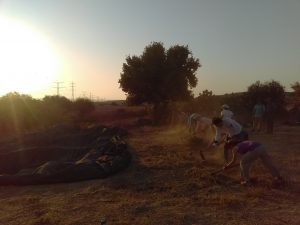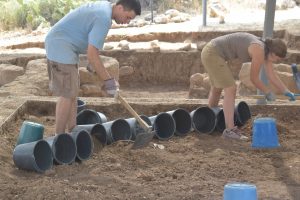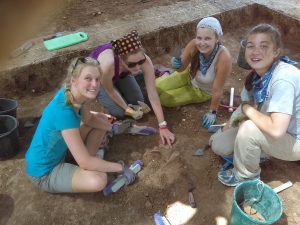
DIGGING AS A HISTORIAN
Christopher W. Jones, 2017 Eric and Carol Meyers Excavation Fellowship Recipient
As a student of the ancient Near East studying in a history department, I have grown used to occupying a somewhat unusual space in both my university and my field. I chose this route because I wanted to pursue an integrative approach to utilizing both textual and archaeological evidence.
I studied historiography and historical methodology during my coursework at Columbia University, but to become well acquainted with archaeology I needed to join a dig and gain firsthand experience. In summers of years past I had previously dug in Ashkelon and at a Catawba Indian site in South Carolina, but I was looking to gain more experience and so in the summer of 2015 I joined Bar-Ilan University’s excavations at Tell es-Safi/Gath.
I spent two seasons at Safi working in the upper city, where we excavated primarily Iron I domestic spaces. For this past season I took the opportunity to move into a supervisory role running a square in a new locale in the lower city known as Area K. Here I had the opportunity to open a new square as part of our continued excavation of an Iron IIA industrial installation which had begun to be excavated the previous season.
I had already accumulated several seasons worth of dig experience, so how did this summer help me become a better archaeologist and thereby become a better ancient historian?
First, running a square gave me a better understanding of how archaeology works. I was now responsible for identifying soil types and changes, marking the boundaries of new loci, and making numerous small decisions about how to excavate and how to record what was being excavated. Recording this data causes one to visualize the layers and history of the square being excavated in a way that was never quite as clear to me before. One can only learn such skills in the field. Having had the opportunity to learn them, I know they will prove invaluable in understanding other archaeological field reports which I will undoubtedly encounter during the course of my research.
Second, it’s one thing to interpret and record finds, but the surest way to know when you have learned something is when you are called upon to teach it to other people. Fortunately, I worked with an amazing team of volunteers from Colorado Christian University who were all highly motivated to learn about archaeology and put in long hours of physical labor unearthing the ancient past. I found that supervising gave me more confidence in my assessments of the finds, as I not only had to explain my observations to my own supervisors who wandered over ever so often to check on my square but also to the undergraduates I was responsible for teaching. Often, there is nothing more helpful for solving a knotty problem then simply asking a volunteer “what do you see here?” and listening to their observations.
Third, as an ancient historian whose dissertation work is primarily based on textual sources, working on an archaeological dig helps bring home the materiality of the past. I am writing a dissertation on officials in the Neo-Assyrian empire, whose letters are often concerned with the productivity of workers and the production and storage of goods. Excavating material remains of the first millennium helps to understand texts within the context of the material world which produced them.
Nevertheless, there are some key differences. The Iron IIA at Tell es-Safi ends in a violent destruction at the hands of Hazael of Damascus at c. 830 BC. At this time the Assyrian empire had reached Phoenicia and Israel as attested in the various inscriptions of Shalmaneser III, but in Philistia it was still a distant threat. What we are excavating is a snapshot of social and economic life in Philistia before Assyrian domination.
What changed in Philistia after the Assyrians arrived? The relevant sites for this period are located elsewhere, most notably Ekron. At Tell es-Safi we are building a picture of what life was like before Assyria. Once we have both pictures we will be able to better understand what changed.
As a historian, I hope to be able to integrate evidence such as this to better understand the process of Assyria’s rule over its imperial territories. More seasons are needed at Tell es-Safi to better understand the economy of the region in the ninth century, and I hope to participate in more seasons there. Even so, thanks to ASOR my work this past summer provided me with plenty of experience in the field which will be incredibly useful to my future scholarly endeavors.


